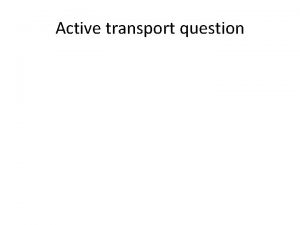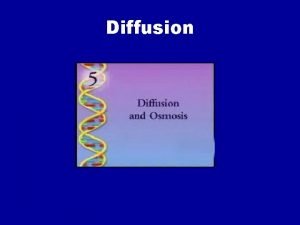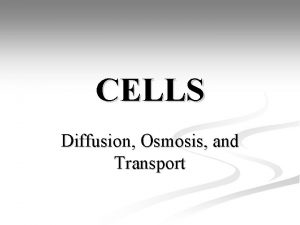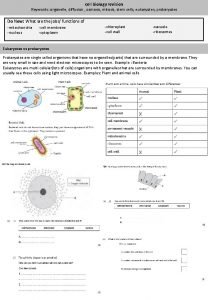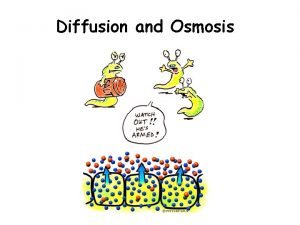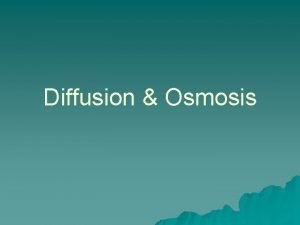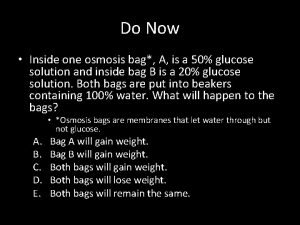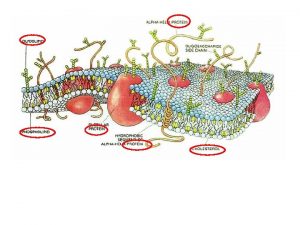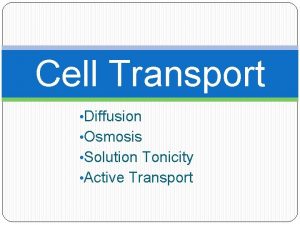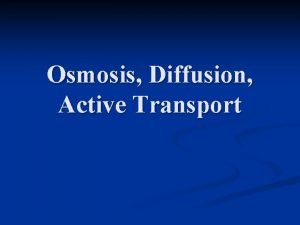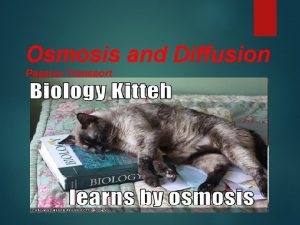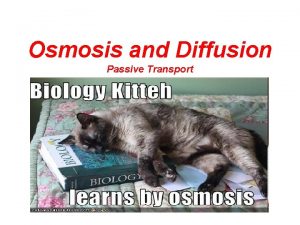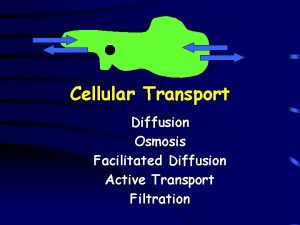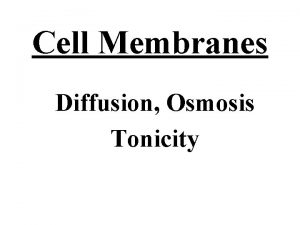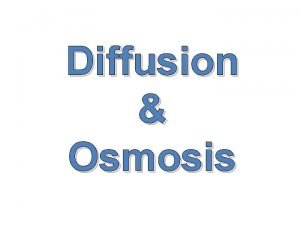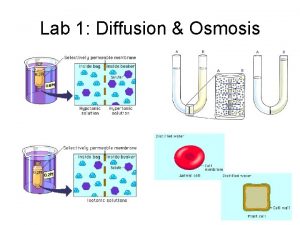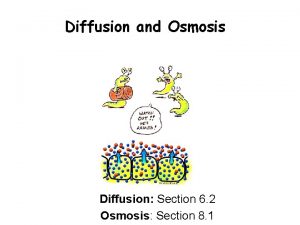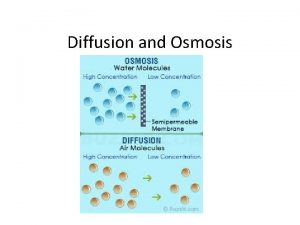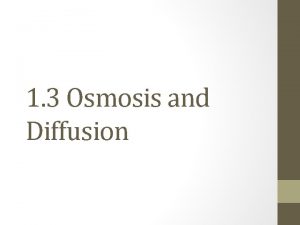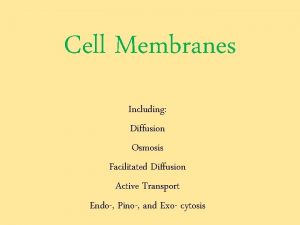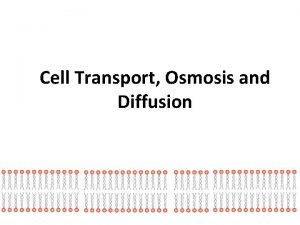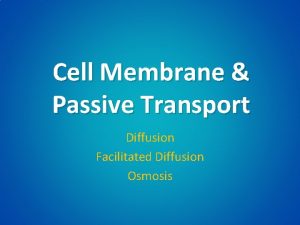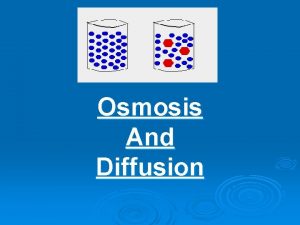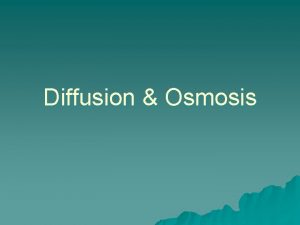Cell Transport Diffusion Osmosis Solution Tonicity Active Transport





















- Slides: 21

Cell Transport • Diffusion • Osmosis • Solution Tonicity • Active Transport

Diffusion Movement of particles from an area of high concentration to an area of low concentration without the use of energy. particles move with the C O N C E N T R A T I O N G R A D I E N T High Concentratio n Movement of particles Low Concentratio n

Diffusion When the particles are even throughout a space - it has reached

Outside of cell Mosaic of Molecules Carbohydrate chains Proteins Cell membrane Inside of cell (cytoplasm) Protein channel Lipid bilayer �Phospholipid Bilayer o Embedded proteins form channels and pumps o Attached carbohydrates act chemical ID cards identifying the cell

Cell Membrane o. Regulates what enters and exits the cell o Selectively Permeable o. Provides protection and support o. Lipid Bilayer o 2 Flexible Layers o. Forms a strong barrier between the cell and its Cell Membrane Video surroundings

Phospholipid Structure �The polar Phosphate group is Hydrophilic �Water loving �The non polar fatty acid tails are Hydrophobic. �Does not like

Selectively Permeable Only allows certain molecules to pass through it.

Diffusion Through Cell Boundaries

Osmosis The diffusion of water through a selectively permeable membrane.

Osmotic Pressure For organisms to survive, they must have a way to balance intake and loss of water. Osmosis exerts pressure (osmotic pressure) on the hypertonic side of the membrane.

Tonicity The osmotic pressure or tension of a solution, as in the cells would swell or shrink depending on the tonicity of the environment. Hypotonic, Isotonic and Hypertonic video

Tonicity We are referring to the amount of dissolved substances within the cell in relation to the amount of dissolved substances outside the cell (in the solution). Hypotonic, Isotonic and Hypertonic video

Hypertonic Solutions Contain a higher concentration of solutes (dissolved substances) than the cell. Water moves out of the cell causing it to shrivel. ANIMAL CELL PLANT CELL

Isotonic Solutions Contain the same concentration of solutes (dissolved substances) as the cell. Water moves freely in and out of the cell maintaining equilibrium. ANIMAL CELL PLANT CELL

Hypotonic Solutions Contain a lower concentration of solutes (dissolved substances) than the cell. Water moves into the cell causing it to swell and possibly burst. ANIMAL CELL PLANT CELL

Facilitated Diffusion (Passive Transport) The movement of particles across the cell membrane with the aid of transport proteins (protein channels). does not require energy

Facilitated Diffusion (Passive Transport) High Concentration Example: Red blood cells have a channel that allows glucose to pass through it in either direction Low Facilitated Diffusion Video Glucose Molecules Cell Membrane Concentration Protein Channel

Active Transport Cells sometimes need to move materials against concentration. Requires energy And the help of a membrane protein Sodium(Na+) Potassium(K+) Pump Video

Summary Does Not require Energy Requires Energy

Endocytosis o Large molecules and even solid clumps of materials may be transported into the cell by the folding in of the cell membrane. o Phagocytosis o The taking in of food o Pinocytosis o The taking in of liquids

Exocytosis The release of large amounts of materials from the cell.
 Primary vs secondary active transport
Primary vs secondary active transport Primary active transport vs secondary active transport
Primary active transport vs secondary active transport Active transport low to high
Active transport low to high Secondary active transport
Secondary active transport Facilitated diffusion and active transport
Facilitated diffusion and active transport Diffusion vs active transport
Diffusion vs active transport Diffusion vs active transport
Diffusion vs active transport Plant cells isotonic
Plant cells isotonic Types of diffusion
Types of diffusion Diffusion osmosis
Diffusion osmosis Receptor - mediated endocytosis
Receptor - mediated endocytosis Define osmosis
Define osmosis Now answer the questions
Now answer the questions Passive transport vs active transport venn diagram
Passive transport vs active transport venn diagram Unlike passive transport, active transport requires *
Unlike passive transport, active transport requires * Bioflix activity membrane transport active transport
Bioflix activity membrane transport active transport Active transport and passive transport
Active transport and passive transport Bioflix membrane transport
Bioflix membrane transport Wallway is a new general herbicide
Wallway is a new general herbicide Does osmosis require energy
Does osmosis require energy Relocation diffusion diagram
Relocation diffusion diagram Example of active transport in a cell
Example of active transport in a cell






